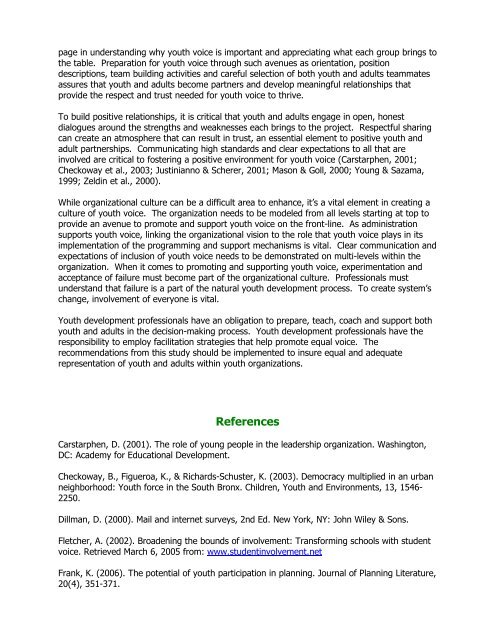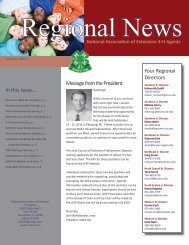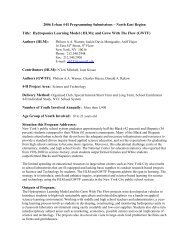page in understanding why youth voice is important and appreciating what each group brings tothe table. Preparation for youth voice through such avenues as orientation, positiondescriptions, team building activities and careful selection <strong>of</strong> both youth and adults teammatesassures that youth and adults become partners and develop meaningful relationships thatprovide the respect and trust needed for youth voice to thrive.To build positive relationships, it is critical that youth and adults engage in open, honestdialogues around the strengths and weaknesses each brings to the project. Respectful sharingcan create an atmosphere that can result in trust, an essential element to positive youth andadult partnerships. Communicating high standards and clear expectations to all that areinvolved are critical to fostering a positive environment for youth voice (Carstarphen, 2001;Checkoway et al., 2003; Justinianno & Scherer, 2001; Mason & Goll, 2000; Young & Sazama,1999; Zeldin et al., 2000).While organizational culture can be a difficult area to enhance, it’s a vital element in creating aculture <strong>of</strong> youth voice. The organization needs to be modeled from all levels starting at top toprovide an avenue to promote and support youth voice on the front-line. As administrationsupports youth voice, linking the organizational vision to the role that youth voice plays in itsimplementation <strong>of</strong> the programming and support mechanisms is vital. Clear communication andexpectations <strong>of</strong> inclusion <strong>of</strong> youth voice needs to be demonstrated on multi-levels within theorganization. When it comes to promoting and supporting youth voice, experimentation andacceptance <strong>of</strong> failure must become part <strong>of</strong> the organizational culture. Pr<strong>of</strong>essionals mustunderstand that failure is a part <strong>of</strong> the natural youth development process. To create system’schange, involvement <strong>of</strong> everyone is vital.Youth development pr<strong>of</strong>essionals have an obligation to prepare, teach, coach and support bothyouth and adults in the decision-making process. Youth development pr<strong>of</strong>essionals have theresponsibility to employ facilitation strategies that help promote equal voice. Therecommendations from this study should be implemented to insure equal and adequaterepresentation <strong>of</strong> youth and adults within youth organizations.ReferencesCarstarphen, D. (2001). The role <strong>of</strong> young people in the leadership organization. Washington,DC: Academy for Educational Development.Checkoway, B., Figueroa, K., & Richards-Schuster, K. (2003). Democracy multiplied in an urbanneighborhood: Youth force in the South Bronx. Children, Youth and Environments, 13, 1546-2250.Dillman, D. (2000). Mail and internet surveys, 2nd Ed. New York, NY: John Wiley & Sons.Fletcher, A. (2002). Broadening the bounds <strong>of</strong> involvement: Transforming schools with studentvoice. Retrieved March 6, 2005 from: www.studentinvolvement.netFrank, K. (2006). The potential <strong>of</strong> youth participation in planning. Journal <strong>of</strong> Planning Literature,20(4), 351-371.
Hillison, J. (1996). Agricultural Education and Cooperative <strong>Extension</strong>: The early agreements.Journal <strong>of</strong> Agricultural Education, 37(1), 9-14.Hirschi, T. (1969). The causes <strong>of</strong> delinquency. Berkley, CA: University <strong>of</strong> California Press.Hoover, A., & Weisenbach, A. (1999). Youth leading now! Securing a place at the table. NewDesigns for Youth Development, 15(3), 29–35. Retrieved on March 21, 2005 from:http://www.cydjournal.org/NewDesigns/ND_99Sum/Hoover.htmlJustinianno, J., & Scherer, C. (2001). Youth voice: A guide for engaging youth in leadership anddecision-making in service-learning programs. Washington, DC: Points <strong>of</strong> Light Foundation.Knowles-Yánez, K. (2005). Children’s participation in planning processes. Journal <strong>of</strong> PlanningLiterature, 20(1), 3–14.Kothari, R. (1996, December). Youth participation in youth development. Paper presented atthe Annual Meeting <strong>of</strong> the Comparative and International Education Society in Mexico City,Mexico.Laidlaw Foundation. (2001). Youth as decision makers: Strategies for youth in governance anddecision-making in recreation. Retrieved on March 26, 2005 from:http://www.laidlawfdn.org/files/YADM-fullreport.pdfLarson, R. (2000). Toward a psychology <strong>of</strong> positive youth development. American Psychologist,55(1), 170-183.Mason, H., & Goll, R. (2000). Youth-adult review <strong>of</strong> research findings: Hampton Coalition forYouth (Appendix A). In Zeldin, S., McDaniel, A., Topitzes, D., & Calvert, M. Youth indecisionmaking.Washington, DC: <strong>National</strong> 4-H Council. Retrieved March 5, 2005 from:www.atthetable.comMeucci, S., & Redmon, J. (1997). Safe spaces: California children enter a policy debate. SocialJustice, 24(3), 139-51.Miles, M.B, & Huberman, A.M. (1994). Qualitative data analysis, 2nd Ed., p. 10-12. NewburyPark, CA: Sage.Ministry <strong>of</strong> Youth Affairs. (2002). Youth development strategy aoteatoroa: Action for child andyouth development. Retrieved on August 29, 2006 from:https://www.myd.govt.nz/uploads/docs/0.7.6.5%20ydsa.pdf<strong>National</strong> Youth Development Information Center (2000). What works: Essential elements <strong>of</strong>effective youth development programs. Retrieved on February 22, 2006 from:http://www.nydic.orgNewsome, J., & Scarela, J. (2001). Youth and boards: What’s the status? San Francisco YouthLeadership Institute. Retrieved on May 4, 2005 from:http://www.theinnovationcenter.org/pdfs/At_the_Table_Catalog.pdf
- Page 2 and 3:
Winter 2008Volume 3 Number 3Editor
- Page 5:
Examining the Potential Unintended
- Page 8 and 9:
centered, multidisciplinary approac
- Page 10 and 11:
Volume 3, Number 3, Winter 2008Arti
- Page 12 and 13:
fostering skill learning and positi
- Page 14 and 15:
Table 1Participation in out-of-scho
- Page 16 and 17:
ResultsOur analyses were conducted
- Page 18 and 19:
watching TV, playing video games or
- Page 20 and 21:
Accordingly, this research augments
- Page 22 and 23:
Dotterer, A.M., McHale, S.M., & Cro
- Page 24 and 25:
A Descriptive View of the 4-H Club
- Page 26 and 27:
In this paper, the results of a cro
- Page 28 and 29:
section is a set of statements that
- Page 30 and 31:
Table 3Experience in the 4-H clubNo
- Page 32 and 33:
significantly higher than Caucasian
- Page 34 and 35:
p
- Page 36 and 37:
This study focused only on the 4-H
- Page 38 and 39:
Theokas, C., Lerner, J.V., Phelps,
- Page 40 and 41:
Volume 3, Number 3, Winter 2008Arti
- Page 42 and 43:
potential for reaching audiences, d
- Page 44 and 45:
Putting Marketing Concepts into Pra
- Page 46 and 47:
2. Find out what others think about
- Page 48 and 49:
Diem, K.G. (1994). What do youth li
- Page 50 and 51:
Promoting Supportive Relationships
- Page 52 and 53:
focused on youth-adult relationship
- Page 54 and 55:
Conversely, more modern educational
- Page 56 and 57:
perhaps most importantly, the effic
- Page 58 and 59:
Organized youth programs, when stru
- Page 60 and 61:
likely to internalize the positive
- Page 62 and 63:
Ellis, J.M., & Caldwell, L.L. (2005
- Page 64 and 65:
Schweinle, A., Meyer, D.K., & Turne
- Page 66 and 67:
Volume 3, Number 3, Winter 2008Arti
- Page 68 and 69:
This study uses the “5 Cs” mode
- Page 70 and 71:
ResultsIn this analysis 48 codes we
- Page 72 and 73:
Table 3Inductive Codes Classified b
- Page 74 and 75:
CompetenceCompetence in organized s
- Page 76 and 77: ecause of him (the coach)…. You d
- Page 78 and 79: practices and competitions, the gir
- Page 80 and 81: Eccles, J.S., & Gootmann, J.A. (Eds
- Page 82 and 83: Smoll, F.L., & Smith, R.E. (2002).
- Page 84 and 85: Volume 3, Number 3, Winter 2008Arti
- Page 86 and 87: The present work builds upon that o
- Page 88 and 89: MethodSample and Data CollectionAs
- Page 90 and 91: (scores ranging from 0 to 8) and a
- Page 92 and 93: Table 2Paired Sample T-tests Compar
- Page 94 and 95: Hypotheses 5 and 6 were tested by c
- Page 96 and 97: De Coverly Veale, D.M.W. (1987). Ex
- Page 98 and 99: Story, M., Neumark-Sztainer, D., Sh
- Page 100 and 101: Volume 3, Number 3, Winter 2008Arti
- Page 102 and 103: Cronbach’s Alpha Score For Youth
- Page 104 and 105: 12 to 18 years old. Fourteen of the
- Page 106 and 107: Therefore, there was a mixed relati
- Page 108 and 109: Youth respondents identified two ob
- Page 110 and 111: are developed through working in a
- Page 112 and 113: Seevers, B.S., & Dormody, T.J. (199
- Page 114 and 115: Volume 3, Number 3, Winter 2008Arti
- Page 116 and 117: With the many opportunities that yo
- Page 118 and 119: meaningfully reduced involving dedu
- Page 120 and 121: StaffingXTime/Schedule X X XTrainin
- Page 122 and 123: “Involving adults that will allow
- Page 124 and 125: “They can't drive or do not have
- Page 128 and 129: Parker, L. (1999). If all youth ser
- Page 130 and 131: Volume 3, Number 3, Winter 2008Arti
- Page 132 and 133: However, the literature is mixed in
- Page 134 and 135: group was the quality of the progra
- Page 136 and 137: Table 1Reasons for Non-Attendance:
- Page 138 and 139: easons given was six. Sixty-three p
- Page 140 and 141: The non-family-related activities t
- Page 142 and 143: “Catch ‘Em Being Good:”An Ext
- Page 144 and 145: In 2001, the WVUES received a schoo
- Page 146 and 147: to leverage the resources of the co
- Page 148 and 149: 4. Most primary behavior incidents
- Page 150 and 151: Recommendations for developing prog
- Page 152 and 153: Cross-Cultural UnderstandingThrough
- Page 154 and 155: that plague these nations such as p
- Page 156 and 157: 2003). Youth leadership training in
- Page 158 and 159: • enable these young people to pa
- Page 160 and 161: We believe that the USPORT program
- Page 162 and 163: West Virginia’s Response to theRo
- Page 164 and 165: Ensuring good oral health requires
- Page 166 and 167: Table 1Correlations between Planner
- Page 168 and 169: problems in this rural state…This
- Page 170 and 171: Volume 3, Number 3, Winter 2008Arti
- Page 172 and 173: vacuum. Determination of factors, a
- Page 174 and 175: ReferencesBaldwin, C., & Caldwell,
- Page 176 and 177:
Volume 3, Number 3, Winter 2008Arti
- Page 178 and 179:
Purpose of StudyThe purpose of this
- Page 180 and 181:
Students in the High computer gamin
- Page 182 and 183:
Do Higher Levels of 4-H LeadershipA
- Page 184 and 185:
IntroductionEmotional Intelligence
- Page 186 and 187:
second section examined demographic
- Page 188 and 189:
a constructive manner. The group is
- Page 190 and 191:
differences in the scores for the 1
- Page 192 and 193:
Adaptability include “Reality Tes
- Page 194 and 195:
ReferencesAmerican Academy of Pedia
- Page 196 and 197:
Healthy Kids, Healthy Families:A Co
- Page 198 and 199:
and a half million U.S. youth (ages
- Page 200 and 201:
Families. In partnering counties, p
- Page 202 and 203:
Healthy Families was then offered a
- Page 204 and 205:
Kamberelis, G., & Dimitriadis, G. (
- Page 206 and 207:
Volume 3, Number 3, Winter 2008Arti
- Page 208 and 209:
Change It Up!What Girls Say About R
- Page 210:
In addition, the study summarizes t






